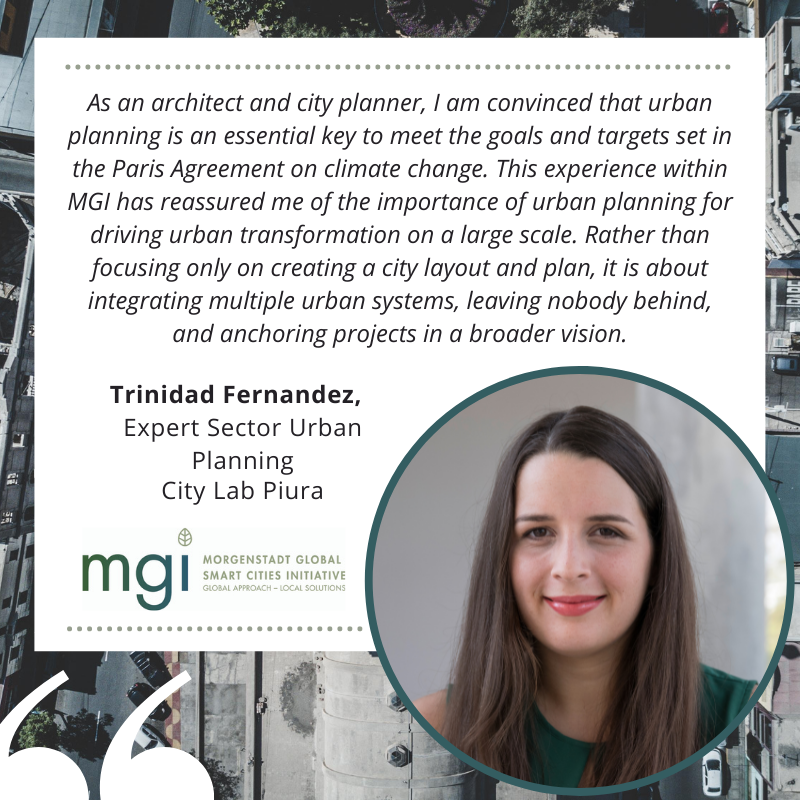Interview with the Urban Planning Expert of the City Lab Piura
Trinidad Fernandez, MGI Deputy Coordinator, Leader for the City Lab Piura and Expert for the Urban Planning Sector, Fraunhofer IAO

Q.: Please elaborate on the method for identifying the sector urban planning and on the reasons for this particular sector in Piura.
A.: In 2019 for the city’s launch event, the team visited different places which were representative and critical for the unique factors of Piura. A kick-off workshop with the participation of local stakeholders was organized. In this event, the challenges in Piura in different sectors were discussed, and the first arguments for taking this sector into account became apparent. The team from Piura together with the municipality prepared a SWOT analysis to build upon the discussions in which urban planning was determined to be one of the focus sectors. The urban planning challenges have been revealed in recent years on how vulnerable the city and its inhabitants are after the El Niño Phenomenon (FEN). Moreover, Piura has become one of the fastest-growing cities in Peru over the last few years, so urban planning is an essential priority for this city.
Q.: Which are the most important factors playing into urban planning in Piura? What are special challenges and opportunities in the city when it comes to urban planning?
A.: The rapid growth, along with other trends related to the planning of a satellite town close to Piura, have led to new challenges in several sectors. However, being one of the cities most affected by climate change, the city has the political support of different actors on the national and international scene in supporting sustainable urban development. City planning should be seen as an integral element in addressing these challenges and must be matched by urban development with basic services for its citizens (water, sewage, energy, solid waste disposal, etc.). Urban planning should not be limited as a tool to formalize land ownership or to protect high-risk natural disaster areas, but also as a strategy to provide a better life for all, especially for the most vulnerable and low-income families.

Q.: Which strategies and tools are/will be used to find innovative solutions related to urban planning for improving the ‘city’s sustainability profile and resilience towards climate risks?
A.: In the MGI project, we have used the Morgenstadt comprehensive approach and methodology for the three cities to understand the urban challenges, reflect on them and co-create smart, integrated and sustainable long-term strategies and projects to address them. In the case of the urban planning sector, we have worked on the project and produced maps with many information layers. These documents will help not only to understand the challenges but also to identify possible action clusters or focus areas for the project ideas.
Q.: Are there tangible examples for solutions or projects in the sector city planning, yet?
A.: Crises like floods caused by the El Niño Phenomenon and the Covid-19 pandemic that affected Piura recently highlight the need for better urban planning, hence the political will to work on this issue. Some project ideas are being discussed at the municipal level and have been initiated by different local actors. Moreover, a restructuration of the Metropolitan Development Plan of Piura is taking place, and our City Lab project had the chance to contribute with some observations for the city diagnosis. In December 2020, we started a virtual on-site analysis, including interviews with relevant stakeholders to discuss the challenges of Piura and co-creating urban development projects and strategies. Being a witness and seeing the first project ideas come to life is very exciting. It is expected that the pilot will focus on the community and the main productive sectors of the city, but not much more can be anticipated at this stage. We are thrilled to know that one of them will be implemented.
Q.: How has your work in the City Labs impacted your perspective on urban planning research? Did it maybe change your perspective or challenge some propositions?
A.: As an architect and city planner, I am convinced that urban planning is an essential key to meet the goals and targets set in the Paris Agreement on climate change. This experience within MGI has reassured me how important urban planning is to drive urban transformation on a large scale. Rather than focusing only on creating a city layout and plan, it is about integrating multiple urban systems, leaving nobody behind, and anchoring projects in a broader vision.

